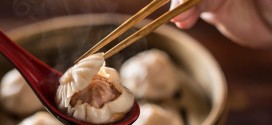Vietnamese Nail Workers Risk Health
By Archana Pyati and Jhee Yoon
Falls Church, VA—Spend an afternoon at your local neighborhood nail salon, and it’s likely your manicurist will be Vietnamese. It’s also possible she (and occasionally he) is risking exposure to toxic chemicals used in salon products.
Nationally, 42 percent of nail technicians are Asian, and Vietnamese workers account for 39 percent of the industry, according to the National Asian Pacific American Women’s Forum, an advocacy group lobbying to make nail salons healthier workplaces. The health risk for salon workers is of particular relevance to northern Virginia with its sizeable Vietnamese population.
There are approximately 2,900 licensed nail technicians and 8,000 licensed cosmetologists qualified to perform nail services in northern Virginia, according to the Virginia Department of Professional & Occupational Regulation. While the state does not break down this information by ethnicity, if the local figures reflect the national trend, over 1,200 nail stylists are AAPI in northern Virginia, with possibly hundreds or thousands more working as licensed cosmologists. Using the national percentage figure of Asian American nail technicians, it can be estimated there are as many as 7,300 AAPI nail salon workers statewide in Virginia, DC, and Maryland, and thousands of cosmologists.
Among the Vietnamese immigrants themselves, there doesn’t appear to be consensus on just how toxic salon products are. Ask Binh “Gene” Nguyen whether the polishes and powders his technicians use to create gorgeous manicures are harmful to their health, and he hedges his response.
“It depends on which chemicals, it depends on how much [the] exposure,” says Nguyen, owner of Nails For You, a Falls Church, Va.-based nail salon and manicurist school.
Take ethyl methacrylate (EMA), a liquid chemical compound used to form acrylic nails, which Nguyen’s classroom textbook labels as toxic if swallowed. “The odor is non-toxic,” says Nguyen. “When you smell it, it’s fine. If you drink it, it will be poison.”
A manicurist drinking toxic liquids is highly unlikely, and that extreme scenario isn’t what worries health advocates. Their main concern is the long-term impact of daily exposure to chemical compounds found in nail salon products, even if they are handled as directed.
“We have an industry that by definition is based on certain chemical building blocks that we know are hazardous to human health,” says Anuja Mendiratta, an environmental health consultant and co-founder of the California Healthy Nail Salon Collaborative and National Healthy Nail and Beauty Salon Alliance.
These hazardous compounds include toluene, a solvent; formaldehyde, a preservative; and dibutyl pthlalate, a plasticizer. Together they’re known as “the toxic trio.” There are also acrylic polymers, including EMA and the highly toxic methyl methacrylate (MMA), which the FDA restricted in the 1970’s. All of these ingredients, which create the look and durability of nail polishes and enhancements, have been linked to respiratory and skin problems, headaches, hormonal disruption, and even reproductive harm. Dibutyl phthalate was banned from cosmetics in Europe, and some consumer groups are demanding that similar action be taken here.
Changing a $6 billion industry isn’t easy, especially when cosmetics manufacturers have yet to offer less toxic alternatives that are affordable and create the look customers have come to expect.
In this area, non-profit organizations have stepped in where local governments have offered little regulation, enforcement, or worker outreach. Two Washington D.C.-based organizations, the Vietnamese-American Community Service Center and Many Languages, One Voice, have trained manicurists who live in the District on the safe handling of salon products and licensing requirements. The Falls Church branch ofBoat People SOS, a service organization for Vietnamese immigrants, has received a grant from the Occupational Safety & Health Administration (OSHA) to conduct training on chemical hazards in nail salons.
Nationally, the U.S. Environmental Protection Agency and the Occupational Health & Safety Administration have created bilingual publications that discuss proper storage, use, and disposal of salon products. The White House Initiative on Asian Americans and Pacific Islanders has created an “interagency working group” in order to coordinate efforts by the EPA, OSHA, the Food & Drug Administration, and other federal agencies to create programming, draft regulations, and conduct outreach on the health and safety of salon workers.
Meanwhile, as health advocates attempt to reach more workers, they’re confronted by an industry where owners and workers often come from the same community, or even the same family. A 2011 study by the Professional Beauty Association notes that Vietnamese immigrants see salons as an attractive way to become small business owners. The study cites a survey of Vietnamese nail salons showing nearly 30% of technicians are male, many of whom work for their own family businesses.
“You wouldn’t have the doctors and lawyers in the next generation if their mothers and grandmothers weren’t nail technicians,” says Nguyen. While he acknowledges the toxicity of products his employees use, Nguyen remains unconvinced that constant exposure causes significant health problems, citing the number of manicurists he has trained who have gone on to have “healthy, beautiful children.”
Among them is Tuyen “Stacey” Nguyen, a 30-year-old mother of two who grew up in the nail business and has a loyal client base at Nails For You. She says she has never experienced headaches, allergies, or skin irritation because of her work, yet acknowledges that nail polish odors bother her. That’s why she is glad clients have switched over to “gel” polish, an odorless substance that is set by a UV lamp, but which experts say poses its own unique health risks.
“Weaving safety into a thriving and sustainable nail industry” is the strategy of Asian Health Services of Oakland, Ca., according to Julia Liou, who manages the California Healthy Nail Salon Collaborative. “The bottom line is that this is their economic cornerstone,” says Liou. “People are often very scared to talk about (toxins in the workplace). If they talk about it, their first question is always, ‘What does this mean? Am I going to have to stop working?’”
Nguyen, Nails For You owner, believes that installing a state-of-the-art ventilation system, requiring manicurists to wear masks and gloves and empty trash bins frequently, and proper training on how to handle and store salon products, are adequate safeguards.
But these are what Dr. Thu Quach calls “back-end solutions,” which don’t address the problems of dangerous substances or the lack of effective government oversight. The FDA holds regulatory authority over cosmetics, yet labeling requirements on wholesale products are lax compared to those sold to consumers in retail settings.
Quach, a research scientist with California Cancer Prevention Institute and research director at Asian Health Services, has spent a decade studying Vietnamese nail salon workers. She reports a majority of workers she surveyed reported concerns about their health from exposure to chemicals and a sizeable proportion reported acute health problems—skin and eye irritation, breathing difficulties and headaches — associated with solvent exposure. “The solution is for these chemicals to not be there in the first place,” says Quach.
It’s all a reminder that beauty may be skin deep, but its costs can go much deeper.
The National Asian Pacific American Women’s Forum provides bilingual information on its website to discuss salon product safety.
 Asian Fortune Your source for all things Asian American
Asian Fortune Your source for all things Asian American



